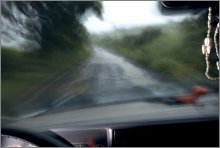Extreme Driving Situation Programs on the Rise in Response to #1 Cause of Teen Death: Teen Driving
by www.SixWise.com
Automobile accidents are the leading cause of death for teens.
The risk holds true for youths aged 15 to 20, but is most
pronounced for 16-year-olds, who are just starting to drive
and have limited driving experience combined with an immature
attitude toward risk-taking.
|

Teen drivers aged 16-19 have a fatality rate four times
the rate of drivers aged 25-69.
|
According to the National Highway Traffic Safety Administration
(NHTSA), 16-year-olds are more likely to be in car crashes
involving excessively high speeds, loss of control, driver
error, and no seat belt use. Driving at night and with other
teen passengers in the car significantly increases these risks.
Although 15- to 20-year-olds make up just 7 percent of licensed
drivers, they are responsible for 20 percent of all reported
collisions and 14 percent of fatalities. According to NHTSA:
-
In 2004, 7,386 people were killed in crashes involving
drivers ages 16-20.
-
Teen drivers aged 16-19 have a fatality rate four times
the rate of drivers age 25-69, based on estimated miles
traveled annually.
-
Sixteen-year-old drivers have a crash rate three times
more than 17-year-olds, five times greater than 18-year-olds,
and two times greater than 85-year-olds.
Why High School Driver Education May Not be Enough
Most teens learn driving skills through a high school education
course. Although this is convenient and effective as far as
basic skills go, many crashes involve teenage attitudes and
decision-making skills, along with pure lack of experience
-- things not always covered in a typical driver's ed course.
To buttress high school education courses, a number of one-day
teen driving schools have popped up to help teach teens "hands-on"
driving experience in real-world, extreme situations. The
courses -- some of which are offered free of charge -- teach
teens how to handle slippery roads, curves they approach too
fast, emergency braking and other essential driving skills.
"Driver's Edge" Teaches Teen Drivers Essential
Skills -- for FREE!
If you would like to enroll your teen in a booster driving
course, Driver's
Edge, a non-profit organization, is an excellent option.
In short, Driver's Edge is a no-cost educational program for
young drivers (aged 15-21) that teaches real-life emergency
avoidance and response techniques, and overall driver safety.
The program is effective (they boast a 53 percent reduction
in collisions over a 12-month period, according to surveys),
yet is taught with an "MTV flavor" that keeps teens
interested and focused.
During the half-day course, teens experience hands-on driving
instruction, including:
-
Evasive lane change maneuvers
-
ABS and non-ABS braking exercises and comparisons
-
Panic braking instruction
-
Skid control instruction
Meanwhile, interactive presentations teach teens (and their
parents):
-
The development of safe driving practices
-
Awareness of surroundings and proper use of anticipatory
vision
-
Tire safety
-
Proper seating, steering wheel and mirror position
-
The dangers of impaired driving, provided by local law
enforcement officials
-
Basic essential car care instruction
The Driver's Edge programs are conducted on a National Tour
(with different cities visited on specific dates, as well
as in Las Vegas, Nevada on an ongoing basis). If you would
like to be notified when the 2007 schedule is available, you
can add your contact information to their notification
list.
Other One-Day Teen Driving Courses for 2007
Other driver education options for your teen (some of which
charge a fee) include:
-
Street
Survival, offered in over 40 locations in 2007 (cost
is $60)
-
BMW
Teen School, offered in Spartanburg, South Carolina
(cost is $400 for one day, $700 for two days)
-
Bob
Bondurant Advanced Teenage Driving, offered in Phoenix,
Arizona (cost is $1,175 for one day, $2,195 for two days,
$3,095 for three days).
-
Skip
Barber New Driver Program, offered near Monterey,
California (cost is $795)
Parents, Teen Driving Tips to Share With Your Child
|

To help reduce the risk of an accident, parents should
restrict their teen's nighttime driving and limit the
number of passengers their teen is allowed to have in
the car.
|
Whether you opt to enroll your teen in an extreme driving
course or not, the following tips from the NHTSA will help
keep your teen safe behind the wheel:
-
Restrict night driving. Most fatal teen car crashes occur
from 9 p.m. to midnight.
-
Restrict passengers. Teen passengers can distract the
driver, encourage greater risk-taking, and are linked
with an increased risk of accidents.
-
Supervise practice driving. Go with your teen on a variety
of practice runs to drive in a variety of situations and
areas.
-
Be a safe driver yourself. Remember, you're a role model
for your teen!
-
Require safety-belt use. Don't just assume your teen
is using the safety belt -- tell them it's a requirement.
-
Prohibit drinking. As with safety belts, don't assume
your teen knows not to drink and drive. Tell them that
it's both illegal and highly dangerous.
-
Choose a safe vehicle for your teen to drive. Don't worry
about image -- avoid small cars, which don't offer much
protection, high-performance cars that might encourage
speeding, and trucks and sport utility vehicles, which
are prone to roll over.
Recommended Reading
How
to Talk to a Teenager (and Know That They're Listening)
Emotional
Abuse in Teen Dating Relationships: What Every Parent Needs
to Know
Sources
National
Highway Traffic Safety Administration
Kiplinger.com
Teen
Driving Foundation